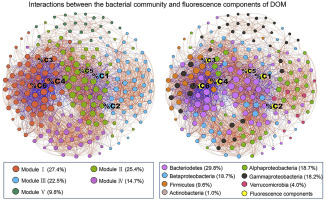Water Research ( IF 11.4 ) Pub Date : 2019-05-17 , DOI: 10.1016/j.watres.2019.05.048 Lei Zhou , Yongqiang Zhou , Yang Hu , Jian Cai , Xin Liu , Chengrong Bai , Xiangming Tang , Yunlin Zhang , Kyoung-Soon Jang , Robert G.M. Spencer , Erik Jeppesen

|
Dissolved organic matter (DOM) from alpine glaciers is highly biolabile and plays a vital role in the biogeochemical cycle of meltwater-impacted environments. To unravel the composition and interactions of DOM with the bacterial community in glacier and glacier meltwater, we conducted sampling of two different Tibetan Plateau glaciers and carried out laboratory bio-incubation experiments. The field data revealed that four protein-like components accounted for 86.0 ± 11.9% of the total variability of all six fluorescence components, which suggests a predominantly microbial source of glacial chromophoric DOM (CDOM). The ice and meltwater samples displayed major contributions of molecular formulae associated with lipids and proteins (i.e. high H/C) as revealed by ultrahigh resolution mass spectrometry. Multiple linear regression models revealed that the abundant phyla explain 64.2%, 61.3%, and 65.0% of the variability of microbial and terrestrial humic-like, and protein-like components, respectively. Correlation-based network analysis determined the metabolic niches of the bacterial community members associated with different fluorescence types in biogeochemical processes. Furthermore, laboratory DOM bio-incubation experiments confirmed that sub-components of the CDOM pool differentially participate in bacterial metabolism. We therefore conclude that the bacterial community interacted closely with the compositional variability of DOM in the investigated alpine glacial environments by both producing and consuming of DOM.
中文翻译:

青藏高原冰川生态系统中微生物的产生和溶解性有机物的消耗
来自高山冰川的溶解有机物(DOM)具有高度的生物不稳定性,并且在受融水影响的环境的生物地球化学循环中起着至关重要的作用。为了揭示冰川和冰川融水中DOM与细菌群落的组成和相互作用,我们对两种不同的青藏高原冰川进行了采样,并进行了实验室生物温育实验。现场数据显示,四种蛋白质样成分占所有六个荧光成分总变异性的86.0±11.9%,这表明冰川生色DOM(CDOM)的主要微生物来源。冰和融化水样品显示出与脂类和蛋白质相关的分子式(即高H / C)的主要贡献,这是超高分辨率质谱显示的。多元线性回归模型表明,丰富的门分别解释了微生物和陆地腐殖质样和蛋白质样组分的变异性的64.2%,61.3%和65.0%。基于相关性的网络分析确定了生物地球化学过程中与不同荧光类型相关的细菌群落成员的代谢位。此外,实验室DOM生物温育实验证实CDOM库的子组件差异地参与细菌代谢。因此,我们得出的结论是,在研究的高山冰川环境中,细菌群落与DOM的组成变异密切相关,通过产生和消耗DOM共同作用。和蛋白样成分。基于相关性的网络分析确定了生物地球化学过程中与不同荧光类型相关的细菌群落成员的代谢位。此外,实验室DOM生物温育实验证实CDOM库的子组件差异地参与细菌代谢。因此,我们得出的结论是,在研究的高山冰川环境中,细菌群落与DOM的组成变异密切相关,通过产生和消耗DOM共同作用。和蛋白样成分。基于相关性的网络分析确定了生物地球化学过程中与不同荧光类型相关的细菌群落成员的代谢位。此外,实验室DOM生物温育实验证实CDOM库的子组件差异地参与细菌代谢。因此,我们得出的结论是,在研究的高山冰川环境中,细菌群落与DOM的组成变异密切相关,通过产生和消耗DOM共同作用。实验室DOM生物孵育实验证实,CDOM库的子组件差异地参与细菌代谢。因此,我们得出的结论是,在研究的高山冰川环境中,细菌群落与DOM的组成变异密切相关,通过产生和消耗DOM共同作用。实验室DOM生物孵育实验证实,CDOM库的子组件差异地参与细菌代谢。因此,我们得出的结论是,在研究的高山冰川环境中,细菌群落与DOM的组成变异密切相关,通过产生和消耗DOM共同作用。















































 京公网安备 11010802027423号
京公网安备 11010802027423号